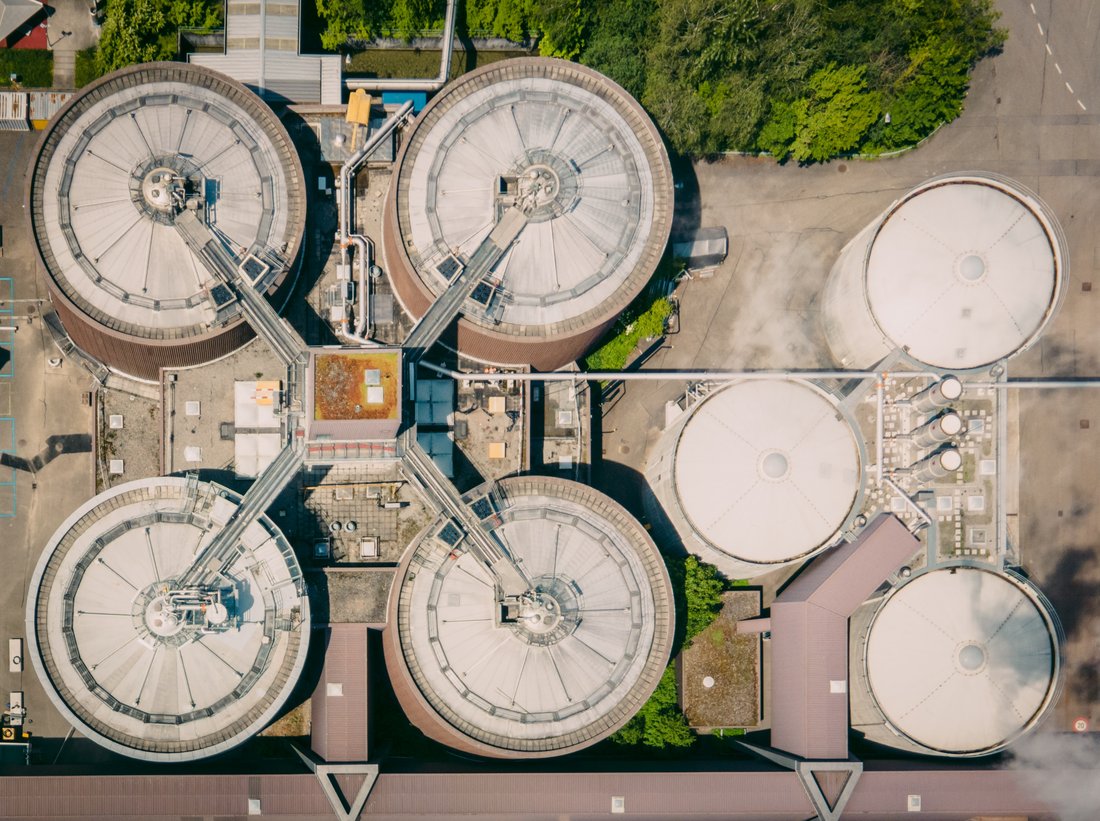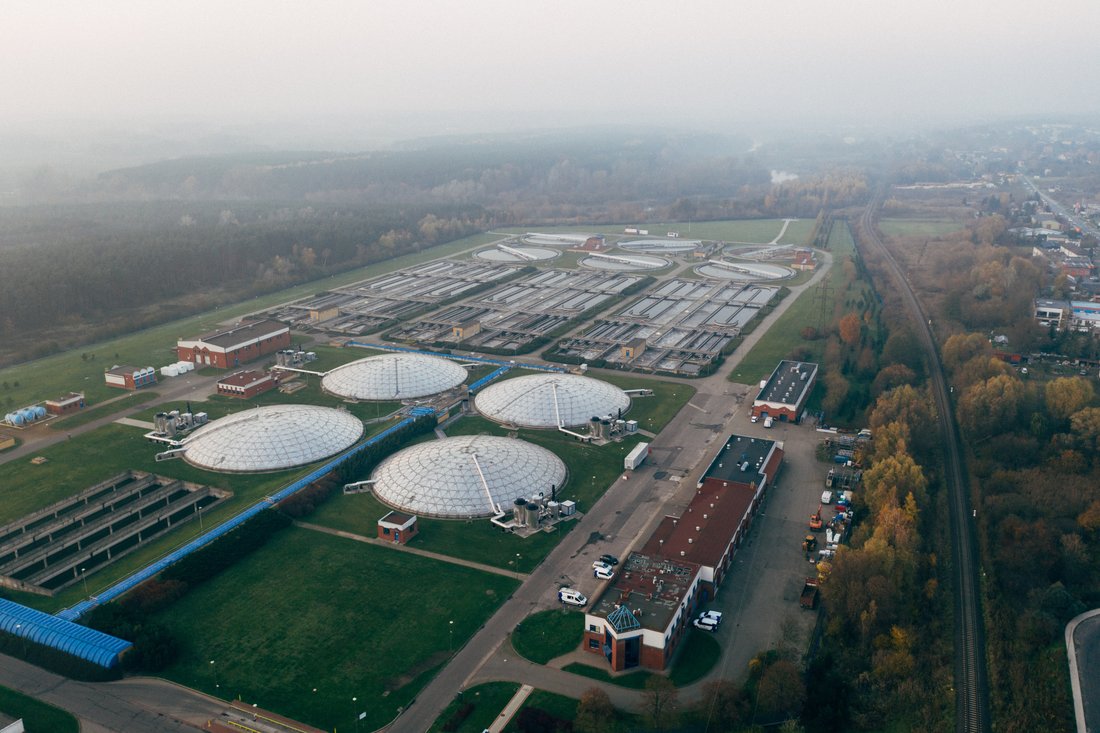Aquathermy from waste water: Using sewage treatment plants for dual energy production
Facts and figures on wastewater in Germany
There are almost 9,000 wastewater treatment plants in Germany, which dealt with around 9.05 billion cubic metres (9047942000 m³ - source: DESTATIS) of wastewater in 2019 and then discharged it into surface waters. In the process, almost 100 % of the wastewater was treated biologically, i.e. with the help of bacteria, in order to produce clean water again.

Photo by Patrick Federi on Unsplash
Biogas for electricity generation from the digestion tower
Today, the majority of sewage treatment plants already produce and use biogas, which is produced in the digestion towers.
Sewage sludge utilisation as gas: In this process, pollutants and carbon from the wastewater are already mechanically filtered as they flow into the treatment plant. This energy-rich primary sludge, which is rich in organic elements, is fed into a digestion tower to produce sewage gas. There, bacteria multiply in the wastewater under oxygen-free conditions - digester gases such as methane are produced. This can be used directly as fuel or to generate electricity. The gas mixture then drives a turbine, producing sustainable electricity. In addition, the gases generate heat that can be utilised through a heat exchanger.
Sewage sludge utilisation as solid matter: The sewage sludge is mechanically dried and used as fuel. This produces steam, which drives a thermal engine and thus produces environmentally friendly electricity. Since the dried sludge has a high carbon content and thus a good thermal value, it can replace fossil fuels. In this way, sewage treatment plants can not only cover their own electricity consumption and thus become energy self-sufficient, they can also feed surplus electricity into the grid.
For municipalities, these two applications mean lower costs and less CO2 consumption through green electricity. In 2020, for example, sewage treatment plants in Germany produced 1,118 GWh of electricity by converting the biogas produced during sewage sludge digestion to electricity while maintaining a constantly high level of treatment performance. This corresponds to a share of 36 percent of the electricity consumption of the sewage treatment plants.
How does a wastewater treatment plant work?
A conventional sewage treatment plant consists of a primary treatment and a subsequent biological stage for the elimination of carbon, nitrogen and phosphorus compounds. This produces sewage sludge, which is mostly thermally recycled in dried form - in 2021 this was almost 80 % in Germany. The remaining 20 % is recycled.
Phosphorus recovery mandatory from 2029
Filters enable the recycling of valuable raw materials such as phosphorus and nitrogen. They are used to produce fertiliser - a procedure that conserves resources, as the conventional production of nitrogen fertiliser is very energy-intensive. Recycling all the phosphorus available in wastewater could also save about half of the annual phosphorus mineral imports.
Operators of wastewater treatment and sewage sludge incineration plants are obliged by the Sewage Sludge Recycling Ordinance to recover phosphorus from sewage sludge and its ash from 2029 if the sewage sludge contains at least 20 grams of phosphorus per kilo.
Pyrolysis is a promising, innovative process that makes use of both the thermal and the material properties of sewage sludge. The coal obtained from the pyrolysis process, which has a high phosphorus content, can then become soil fertilizer. According to the Fraunhofer IFF, even other utilisation concepts result, such as use as activated carbon in the sewage treatment process to retain pharmaceutical residues or other micro pollutants. The high calorific value gas produced during pyrolysis can also be used as an energy source to generate heat and electricity.[1]
[1]https://www.iff.fraunhofer.de/de/geschaeftsbereiche/energiesysteme-infrastrukturen/crackit.html
Wastewater treatment plants as a source of energy - fully utilising the energy potential of wastewater
In order to utilise the entire energy potential of the wastewater in the sewage treatment plant, it is necessary to combine different technologies.
From a sustainability perspective, wastewater heat utilisation is particularly interesting. However, this thermal source of energy is still often neglected. Wrongly so: if only 1.5 °C of heat is extracted from the wastewater, 6.3 kW of heat can be gained per litre flowing through.
The heat energy is extracted from the wastewater in the sewage treatment plant or the sewer system by means of heat exchangers. It serves as a thermal source for heat pumps. Using electricity, it is raised to a higher temperature level and can then be fed into a heating network. To prevent the heat exchanger from becoming dirty, it must either be cleaned regularly or installed in the outflow of the sewage treatment plant, where the device is only washed around by the already purified clear water.
Wastewater recovery/wastewater heat utilisation:
Wastewater remains relatively warm in winter, averaging 10 to 12°C, and relatively cool in summer, with a maximum of 20°C. These temperatures are perfect for using an energy source with the help of a heat exchanger and a heat pump, which can be used for heating in winter and cooling in summer. Wastewater can be used for this purpose in the sewage treatment plant, but also in the sewage system.
When fed into a district heating network, the energy efficiency of the wastewater heat is increased by short transport routes and low heat losses - an ecologically and financially interesting system for municipalities.
In addition, the heat can also be used in innovative ways: For urban gardening and farming projects such as heating local greenhouses or aquacultures, or for drying animal feed or grain.
The good news is that most modern sewage treatment plants are already technically equipped to generate energy from wastewater and sewage sludge.

Photo by Marcin Jozwiak on Unsplash
Further technologies and possibilities for energy use in the sewage treatment plant
There are already a wide variety of possibilities for obtaining energy from wastewater or sewage sludge, which can be used with the available technologies. In general, utilisation is possible through chemical energy, thermal energy and kinetic energy.
In the case of kinetic energy utilisation, the wastewater in the sewage treatment plant - similar to a hydroelectric power plant - is fed into a turbine via a gradient and thus generates environmentally friendly electricity with a generator.
Power-to-gas solutions can also be realised in a sewage treatment plant: An electrolyser is used to produce hydrogen from the wastewater and, with the addition of CO2 and the help of bacteria, it is converted into methane. Such hydrogen storage facilities can, for example, store surplus wind power as methane. The oxygen produced during hydrogen generation in turn supports wastewater treatment in the process.
The hydrogen can also be used directly: For example, to power local public transport buses and thus reduce emissions - a perfect example of sector coupling.
In addition, the digester can be used as a seasonal heat accumulator for demand-oriented use of the heat.
Advantages of energy generation from waste water
- Biogas and sewage sludge as substitute fuels reduce or avoid the share of fossil fuels for power generation and thus reduce CO2 emissions.
- The heat in the wastewater can be used as an energy source free of charge and climate-neutral by means of heat exchangers and heat pumps.
- The pollutants in the sewage sludge are incinerated or recycled - phosphorus and nitrates as fertiliser.
- Security of supply with constant temperatures throughout the year.
Heat, electricity, clean water and nutrient recovery - if you want to optimise the overall system sustainably, you have to take many factors into account. First and foremost, of course, is ensuring pure, clean wastewater. But municipalities can benefit much more from their wastewater: As a supplier of energy and raw materials, as a guarantor of sustainability and for saving CO2 and financial expenses.
To support the energy and heat transition and to protect the climate, the use of sewage treatment plants as power plants should be clearly promoted. In Germany, millions of households could obtain their electricity and heat from sewage treatment plants and benefit from lower energy and heating costs from renewable sources.
By the way: World Water Day is celebrated on March 20th. In 2023, it is themed under the motto "Accelerating Chance".
With Sustainable Development Goal (SDG) number 6, the United Nations is working to ensure that all people have access to safe and affordable drinking water. To achieve this, sustainable management must be promoted worldwide, the availability of water must be ensured and hygienic sanitation must be guaranteed for all.
Sources and further information:
https://www.umweltbundesamt.de/themen/energie-rohstoffe-aus-klaeranlagen
https://www.uhrig-bau.eu/lexikon/abwasserwaermetauscher/
https://www.process.vogel.de/energie-aus-abwasser-so-wird-das-klaerwerk-zum-kraftwerk-a-776020/
https://dau-gmbh.de/klaeranlage-energiegewinnung/
https://www.bmuv.de/gesetz/verordnung-zur-neuordnung-der-klaerschlammverwertung
https://www.iff.fraunhofer.de/de/geschaeftsbereiche/energiesysteme-infrastrukturen/crackit.html


